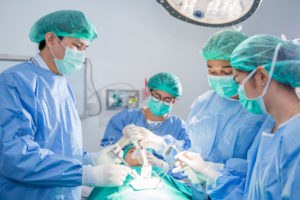Haemorrhoidectomy
Haemorrhoid are vascular structures in anal canal. They act as cushions which help stool control normally. They become a disease when get swollen or inflamed. They will cause bright red rectal bleeding during or after defacation, mucus discharge, perianal mass that prolapse through anus, itchiness or perianal pain. If you have chronic constipation, low fiber diet, prolonged sitting, increased intra-abdominal pressure such as pregnancy, you may have higher chance to develop hemorrhoidal disease.
Haemorrhoids could be divided into internal haemorrhoids and external haemorrhoids
Internal haemorrhoids could be classified into different grade according to their severity
Grade I: No prolapse, just prominent blood vessels
Grade II: Prolapse upon bearing down, but spontaneous reduction
Grade III: Prolapse upon bearing down requiring manual reduction
Grade IV: Prolapse with inability to be manually reduced
Management for grade I and grade II haemorrhoid:
- High fiber diet
- Topical cream or suppositories
- Sclerotherapy
- Rubber band ligation
Rubber band ligation:
This can be performed in clinic. Doctor will introduce an instrument (proctoscope) into your anus and examine the severity of the internal haemorrhoid. Rubber band ligation will be performed if there is grade II internal haemorrhoids. Suction is applied onto the haemorrhoid and a rubber band is applied onto it. The band will cause necrosis of the haemorrhoid. After procedure, you may have perianal discomfort or minimal perianal pain which may lasted for few hours to few days. You may also have small amount of per-rectal bleeding, especially after 10-14 days after banding when the banding sloughs off.
Management for grade III and grade IV haemorrhoid:
- Open haemorrhoidectomy
- Stapler haemorrhoidopexy
Open haemorrhoidectomy:
- Performed for both internal and external haemorrhoid
- Diseased haemorrhoids are excised, which result in wounds over perianal region
- Operative time: 30-45 mins
- There will be wound pain after operation and may last for 1-2 weeks. The post – operative pain is well controlled by analgesic
- Perianal wounds will heal around 6-8 weeks after operation
Stapler haemorrhoidopexy:
- Abnormally enlarged haemorrhoidal tissues are excised, followed by repositioning of the remaining hemorrhoidal tissue back to its normal anatomical position
- Operative time: 30-45 mins
- Not suitable for external haemorrhoids or case of anal stenosis
- Recommended for grade 3 or 4 internal haemorrhoids
- Less post-operative pain and there is no wound over perianal region



